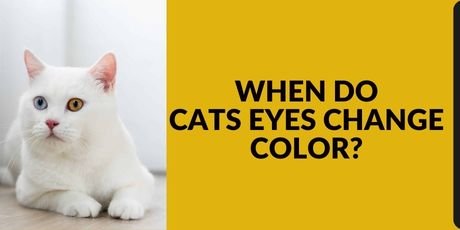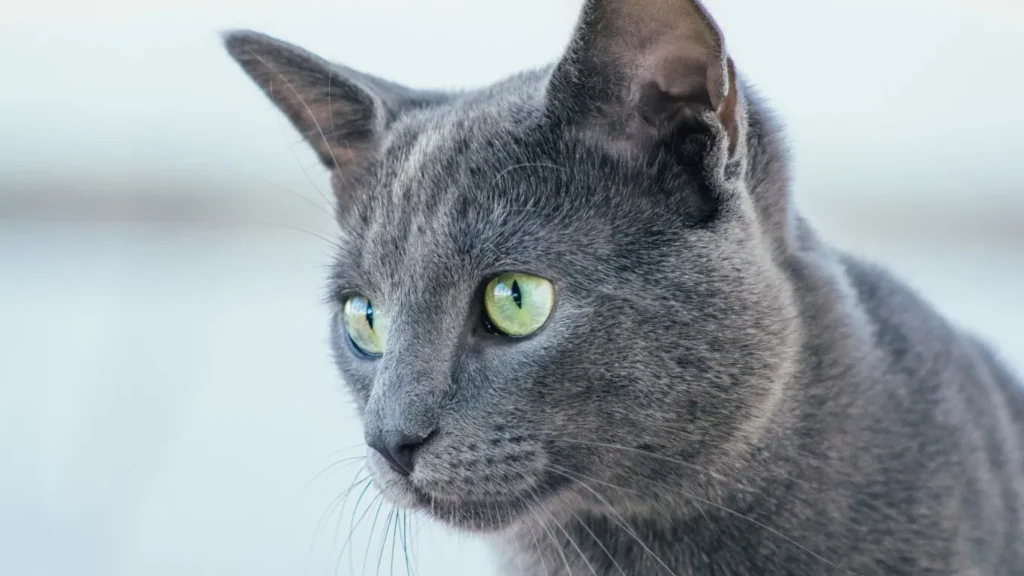A cat’s eyes, known for their stunning appearance, often change color due to a combination of age, health, genetics, and even lighting conditions. This is one of their most distinctive traits. The science behind why and when this occurs reveals much about a cat’s development and overall well-being.
Can A Cat’s Eyes Change Color?
Yes, as a cat ages, their eyes can change color. This change may occur once or multiple times throughout their life. It’s important for cat owners to recognize the difference between a normal, expected color change and one that could indicate health problems. Resources like TeachAboutCatprovide valuable information to help owners learn what to look for in their cat’s eyes as they age.

The Anatomy of Cat’s Eye
The anatomy of a cat’s eye is a complex system comprising several layers. The outermost layer, known as the cornea, is a clear, protective covering that covers the eye’s surface. Beneath this lies the middle layer, the iris, which is the colored part of the eye containing muscles that contract and expand to adjust the pupil size. The pupil, the black center of the eye, plays a critical role in light regulation. The innermost layer is the retina, where cells are responsible for light response, sending signals to the brain to create vision.
Also Read: What is a Cats Average Lifespan?
Why Do Cat Eyes Change Color?
Cat eyes change color due to pigments in the iris. The pigment melanin, which is also found in skin and hair, affects the eye color. A higher concentration of melanin results in darker eye colors, while a lack of melanin leads to lighter shades like blue, green, or yellow.
The dilation and contraction of the pupil also play a role. In bright light, the pupil constricts, making the melanin more concentrated in a smaller area, resulting in a darker appearance. Conversely, in dim light, the pupil dilates, spreading out the melanin over a larger area, making the eyes appear lighter.
Additionally, light reflecting off the tapetum lucidum, a layer of reflective cells behind the retina, enhances eye color in low light conditions. This creates a glowing effect in various shades like dark, gold, green, or blue, contributing to the perception of color changes.
When Do Cat Eyes Change Color?
A cat’s eye color can change due to several factors influenced by their anatomy, an intriguing aspect we’ll explore and understand.
Age:
As cats age, their eyes may change color. Kittens typically have blue eyes due to the absence of melanin, but as they grow and develop, the melanin levels in their iris increase, changing their eye color. This process usually completes by the time they are three to six months old. In older cats, eye color changes can indicate health issues like cataracts, glaucoma, or uveitis, where changes in the lens can become yellow, cloudy, or affect vision loss due to pressure on the optic nerve or inflammation. These changes can make their eyes appear lighter or darker.
Health:
In cats, a change in eye color can be a significant indicator of health issues. Variations from the normal hue may signal an infection or injury, especially if eyes appear red, swollen, or have a yellow to orange tint. An increase in melanin in the iris or changes in the whites of their eyes might indicate conditions like liver disease.
Genetics:
In Cat Breeds like Siamese and Burmese, color-changing eyes are often influenced by a specific gene that responds to temperature and the environment.
Lighting:
The lighting in a room can make a cat’s eyes appear to change color. For instance, in bright sunlight, their eyes might take on a golden or green hue, giving a different appearance than in dimmer conditions.
Cat Eye Color Changes that are Normal & When to Worry
As a cat enthusiast, I’ve always been captivated by the young kitten’s eye color change during the first few months of life. They are born with eyes of a certain hue, which doesn’t always stick around. It’s common to notice their eyes start changing color as they approach the three-month mark. This is a typical pattern and not usually a cause for concern. However, it’s prudent to keep an eye on things – pun intended.
If the color transformation occurs beyond the expected timeframe, it might raise an eyebrow. While often benign, it can also be a sign that something is up. In such scenarios, it’s wise to chat with your vet, especially if you’re concerned.
Why Do Kitten Eyes Change Color?
Kittens, upon entering our world, are typically born with blue eyes. This initial hue is like a blank canvas, displaying the beginning of a colorful journey. The irises of these cute kitten eyes are influenced by special pigment cells called melanocytes, akin to artists painting the iris. During the first three months, a fascinating transformation occurs. The eyes evolve from soft, dreamy blue to a spectrum of shades, possibly becoming rich, glowing amber or another vibrant color.
This curious color transition in your kitty’s eyes can be a hint at their breed. Certain cat breeds are known for signature eye colors, a nod to their ancestry. However, the final shade of their eyes is not just a matter of genetics but a complex interplay of developmental processes. Watching these colors unfold is like witnessing a live painting, with each kitten revealing its unique artistry.
Also Read: Why does My Cat Groom Me?
Heterochromia Causes Eyes of Different Colors
In some cases, a kitten develops eyes of two distinct colors, where both eyes exhibit a different color. This color variation, known as heterochromia, arises from unequal amounts of melanocytes in the irises. Unlike a full-color change that typically completes in the first few months, heterochromia can be a lifelong trait. Although it might seem like a potential medical problem, in most cats, this condition is harmless and makes them stand out with their unique appearance.
Health Issues that Cause Cat Eye Color Changes
After a kitten has developed its true eye color, any change in hue over the course of life can often be attributed to health issues. Unlike the natural progression seen in young kittens, these changes might be due to disease or trauma affecting the eye tissue. Such shifts in color can affect one or both eyes and are important indicators to monitor. Understanding these common causes is crucial for cat owners to ensure timely veterinary care for their feline friends.

Red Eye Color Change Could Be Uveitis
When a cat’s normal eye color shifts to a murky red, it could be an indication of Uveitis an inflammation often stemming from trauma, infection, glaucoma, or even cancer. Identifying the underlying cause is crucial, as the appearance of red eyes, along with accompanying symptoms like tearing, obvious pain, or sensitivity to light, signals a need for immediate attention. A visit to the vet is imperative, where they might prescribe anti-inflammatory meds or recommend surgery depending on the severity and cause of the condition.
Cataracts Cause Milky Eye Color Change
Cataracts can drastically alter a cat’s lens, turning it cloudy and milky looking. This condition can affect one or both eyes and is often linked to injuries, diseases like diabetes or hypertension. Once diagnosed, based on the appearance and obvious loss of vision, the treatment plan focuses on addressing the underlying cause. In severe cases, surgery may be necessary to replace the affected lens with an artificial one, restoring vision and quality of life for our feline companions.
Jaundice Causes Yellow Discoloration
Jaundice in cats, a common byproduct of various liver diseases or conditions like cancer and feline infectious peritonitis, is characterized by the buildup of bilirubin in the cat’s system. This accumulation results in yellow discoloration not just in the whites of the eyes, but also in the skin and mucous membranes. The yellow coloration is often accompanied by worrying symptoms such as lethargy and loss of appetite.
When these signs are observed, consulting a veterinarian is crucial. Through blood tests and urinalysis, they can diagnose the exact cause of jaundice. Treatment then focuses on addressing the underlying cause, which may include hospitalization, intravenous fluids, and nutritional support to help your cat recover.
Corneal Ulcers Make Eyes Look Milky, Cloudy, or Pinkish
Corneal ulcerations occur when the front part of the eye, known as the cornea, becomes damaged, making the cat’s eye appear cloudy, milky, or even pink. These ulcers can result from a scratch by another cat or something stuck in the eye. Often, infections such as feline herpesvirus are also involved. If you’re worried, a quick visit to the vet can clarify the situation. They can easily check for ulcers using a special dye called fluorescein which highlights the damaged spot in green. Treatment usually involves applying meds directly on the eye, like antibiotics, to fend off any nasty infections.
Also Read: Cat Breeds That Don’t Shed?
Corneal Sequestrum Appears as Brown or Yellow Color Changes
Corneal sequestrum presents as brown to black plaques of dead tissue on the cornea, and breeds like Persian, Siamese, Burmese, and Himalayan cats are more frequently affected by this condition. Diagnosis hinges on the appearance of the eye and accompanying symptoms such as tearing and squinting. Treatment options range from antibiotics and anti-inflammatory drops to antiviral therapy. In severe cases, removal of the affected tissue followed by a corneal graft may be necessary to protect the eye as it heals.
Eosinophilic Keratitis Make Eye Color Change to Pink, White, or Gray
Eosinophilic keratitis leads to a pink, white, or gray film developing on the cornea of a cat’s eye. When you spot such changes, consulting a veterinarian for a diagnosis is key. They may take cell samples from the cat’s eye to identify eosinophils and mast cells. It can be difficult to determine the underlying cause of this condition, but once identified, it’s often treated with a topical steroid. Early treatment is crucial to avoid permanent eye damage in your feline companion.
Early Diagnosis Is Key to Treatment
It’s a good idea to take a quick peek at your furball’s eyes every day. Even a tiny change in eye color over time warrants a trip to the vet. Staying on top of it early helps keep those peepers healthy and can help you catch bigger health issues before they become serious. This few seconds check-up is a super simple way to look out for your kitty’s wellbeing.
Conclusion
The journey through a cat’s eye color changes is as fascinating as it is informative, offering a window into their health and development. From the playful hues of a kitten’s evolving eyes to the more serious tones indicating potential health issues, each color shift tells a story. The myriad conditions affecting eye color, such as heterochromia, uveitis, cataracts, and more, remind us of the complexity and sensitivity of our feline friends. As responsible cat owners, understanding these changes is crucial, not just for appreciating their beauty but also for ensuring their well-being. Regular check-ups, prompt veterinary care, and a keen eye for detail can help us safeguard the health of these beloved creatures, whose eyes continue to captivate and mystify us.
People Are Also Interested In:
Why Do Cat Eyes Glow?
Cats have a unique layer of tissue called the tapetum lucidum that reflects light back onto the retina, giving it a second chance to detect light. This glow you often notice in low light conditions is because light that isn’t absorbed on the first pass through gets a second go, increasing the amount of light available for their impressive night vision. In well-lit environments, this reflection is less noticeable.
Why Do Cat Eyes Dilate?
Cats possess the unique ability to control the size of their pupils, allowing them to adjust to the amount of light in their environment. Dilation is a reflexive response to changes: in bright light, pupils contract to become smaller to reduce light intake, and in low light conditions, they dilate to become larger to improve vision. This reaction also occurs in response to emotional or physical stimuli such as excitement, fear, pain, or when a cat feels threatened, helping them react and maintain optimal vision in various situations.
Also Read: What is a Cats Average Lifespan?
Why Are Cat Eyes Slit?
The slit-like shape of a cat’s eyes is an evolutionary adaptation to hunt effectively. As predators, this shape helps them to adjust quickly to changes in light, especially in low-light conditions like dawn or dusk when their prey is most active. The elongated shape allows accurate focus on objects across their visual field, whether they are looking straight ahead or to the side, making their vision particularly acute for judging distances and tracking movement while hunting prey.
How Do You Clean Cat Eyes?
Cleaning your cat’s eyes is an important part of maintaining good hygiene and helping to prevent infection. The steps are simple: use a clean, soft cloth or cotton ball moistened with lukewarm water or a saline solution. Approach your cat calmly and gently, talking in a soothing voice to relax them. Gently wipe away any discharge from the corners of the eyes with a fresh cotton ball for each eye. Afterwards, dry the area with a soft cloth or towel, and don’t forget to reward your cat with treats or playtime to create positive associations with the process.







